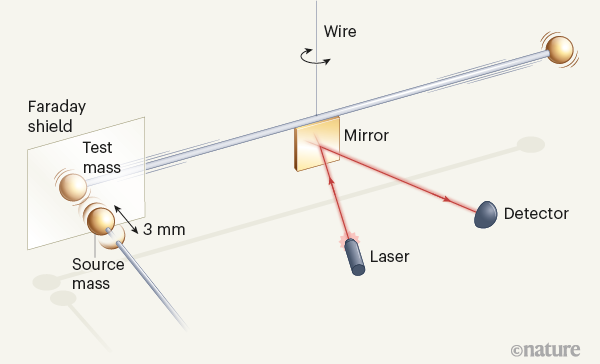

An experiment shows that Newton’s law of gravity holds even for two masses as small as about 90 milligrams. The findings take us a step nearer to measuring gravitational fields that are so weak that they could enter the quantum regime.
Four fundamental forces are known in physics: the weak and strong interactions, and the electromagnetic and gravitational forces. The gravitational force is the weakest of these four. For this reason, and because experiments cannot be shielded from Earth’s gravity, measurements of the gravitational field of a test object are difficult to do in the laboratory — even for objects that have multi-kilogram masses. But writing in Nature, Westphal et al.1 report the detection of the gravitational coupling between two masses of only about 90 milligrams.
The weak, strong and electromagnetic interactions have been unified in the standard model of physics, but the gravitational force cannot be integrated into that model. The best model currently available to describe gravity is the general theory of relativity. This theory has not failed any test so far, but something is odd about it, because it cannot be explained in terms of quantum mechanics.
For most scientific purposes, however, we do not need to use the general theory of relativity to explain gravity — Isaac Newton’s law of universal gravitation2 works perfectly. Published in 1687, Newton’s law states that the gravitational attraction between two bodies is proportional to their masses and inversely proportional to the square of the distance between them. This has proved to be correct not only for describing most astronomical observations, but also in laboratory experiments. For example, the trajectory of a freely falling object (such as an apple falling from a tree) can be measured with a precision of less than ten parts in one billion3, and the results are in good agreement with what would be expected from Newton’s law.
During the twentieth century, however, doubts emerged about the general correctness of this law: an anomalous velocity distribution of stars in galaxies was observed4 in the early 1930s, and could not be explained using Newton’s law alone5. Even the general theory of relativity cannot account for this phenomenon. One explanation is to postulate the existence of dark matter6 — an invisible, but gravity-generating, component of the Universe. However, nobody really knows what this dark matter is made of.
Another explanation, which is controversial but easier to integrate into models than is dark matter, is that Newton’s gravitational law needs a correction. One theory that attempts such a correction was proposed in the 1980s, and is called modified Newtonian dynamics7. The basis of this theory is that gravitational field strength (the acceleration due to gravity) does not follow Newton’s inverse-square law over large distances.
A further mystery is that the gravitational force is about 36 orders of magnitude weaker than the electromagnetic force. This is called the hierarchy problem8.
A framework known as string theory, which was developed in part to provide a quantum-theoretical description of gravity, addresses this problem by proposing that there are more spatial dimensions than the three that we can observe. Gravity — unlike the three other fundamental forces — is assumed to permeate these extra dimensions. If true, then this could explain why the gravitational force is so much weaker than the electromagnetic force9. Another consequence would be that, over a certain spatial range, the gravitational force cannot be described by Newton’s inverse-square law.
A further peculiar thing about gravity is that independent measurements of Newton’s gravitational constant (G, a fundamental constant used in calculations of gravitational effects) have varied broadly10. Experimental determinations of other fundamental constants, such as the Boltzmann constant11 or the speed of light12, have converged as the number and precision of the measurements has increased. This has not happened for G.
Westphal and colleagues’ experiments might take us a step closer to understanding the mysteries of gravity. They have investigated the gravitational force using a miniature version of a torsion balance — a device that was first used by Henry Cavendish in 1798 to measure Earth’s density13 (an experiment that is equivalent to measuring G), and which is still the gold-standard device for determining G14.
A torsion balance consists of a horizontal bar suspended at the middle from a vertically hanging wire, and with test masses attached to the ends. Earth’s gravitational attraction acts in the vertical direction, along which the wire has a large stiffness. But in the horizontal direction, the wire is easily twisted and has a tiny spring constant — very weak forces applied at right angles to the bar cause large rotations of the bar. The balance therefore generates an almost gravity-free environment (more accurately described as a microgravity) in the horizontal plane. This is perfect for detecting small forces, such as the gravitational pull exerted on the bar by a nearby object (the source mass).
In typical determinations of G, the source masses were heavy (several kilograms), to compensate for the weakness of the gravitational force. By contrast, Westphal and co-workers used gold spheres only 92 milligrams in mass (Fig. 1), about the mass of 4 houseflies. This is the lowest source mass ever used in such an experiment.

Figure 1 | How to detect a weak gravitational field. Westphal et al.1 suspended a horizontal bar from a wire, with two masses of about 90 milligrams on each end. They then brought another mass of approximately 90 mg (the source mass) within a couple of millimetres of one of the masses on the bar (the test mass), and periodically altered its position, thereby modulating the ultra-weak gravitational field of the source mass that acts on the test mass. The modulated gravitational field caused the suspended bar to undergo tiny rotational oscillations. A Faraday shield (a gold-plated aluminium screen) was used to suppress electromagnetic interactions between the masses. The motion of the test mass was measured from the displacements of a laser beam reflected from a mirror on the bar, and the distance between the test and source masses was measured with a camera (not shown). These measurements were used to determine the value of G, the fundamental constant used in calculations of gravitational effects.
A calculation using Newton’s law of gravitation shows that the force acting between two spherical masses of 90 mg with a centre-of-mass separation of 2.5 millimetres (approximately the parameters of Westphal and colleagues’ experiment) is only about 9 × 10–14 newtons. This is roughly the same force that acts on a mass of 9 picograms (1 pg is 10–12 g) in Earth’s gravity field; to put that into perspective, 9 pg is about one-third the mass of a human red-blood cell15. The big challenge was therefore to extract this extremely small gravitational signal from background ‘noise’ in the experiment, and from the effects of other forces (such as electromagnetic interactions) that become stronger than gravitational forces when the source and test masses are separated by small distances.
Westphal et al. therefore modulated the signal by periodically varying the position of the source mass with respect to the test mass in the torsion balance. As a consequence of the time-dependent gravitational interaction, the balance oscillated in the horizontal plane at the frequency of the signal modulation (12.7 millihertz). Because the gravitational field of a spherical mass is nonlinear (a consequence of Newton’s inverse-square law), the balance is also stimulated to oscillate at higher frequencies that are multiples of the modulation frequency (known as higher harmonics). This effect could be clearly identified in the experiment, thus providing a signature of the gravitational coupling between the masses.
The detection of such a minuscule gravitational signal is itself an exciting result, but the authors went even further by determining a value for G from their experiment. Their estimate deviates from the internationally agreed value (see go.nature.com/2bwkrqz) by about 9% — a small amount, given that the experimental uncertainties of their system have not yet not been optimized for precise measurements of G. The experiment is therefore the first to show that Newton’s law of gravity holds even for source masses as small as these.
The next step is to push on to even smaller masses — Westphal et al. suggest that gravitational fields of masses of the order of 10–8 kg could eventually be measured. However, much work will need to be done to achieve this goal. The first task will be to substantially reduce damping of the oscillations of the torsion balance, which won’t be easy. But if it can be done, then perhaps quantum gravitational effects will finally be observed.
